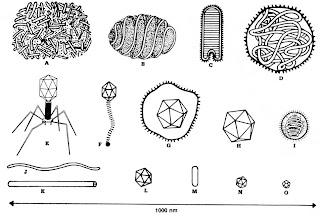I decided to gather from various sources of the history of computer viruses. I have chosen in my opinion the most important events in the period from the late 60's to 2000. Chronology compiled through articles of
THE HISTORY OF COMPUTER VIRUSES, and
A Short History of Computer Viruses and Attacks.
Late 1960s - early 1970s
Periodically on the mainframes at that period of time there appeared programs called "
the rabbit". These programs cloned themselves, occupied system resources, thus lowering the productivity of the system.
The first incident which may be well called an epidemic of "
a computer virus", happened on the Univax 1108 system. The virus called "Pervading Animal" merged itself to the end of executable files - virtually did the same thing as thousands of modern viruses do.
The first half of 1970s
"The Creeper" virus created under the Tenex operating system used global computer networks to spread itself. The virus was capable of entering a network by itself by modem and transfer a copy of itself to remote system. "The Reeper" anti-virus program was created to fight this virus, it was the first known anti-virus program.
1979
Engineers at Xerox Palo Alto Research Center discover the computer "
worm" a short program that scours a network for idle processors. Designed to provide more efficient computer use, the worm is the ancestor of modern worms - destructive computer viruses that alter or erase data on computers, often leaving files irretrievably corrupted.
1981
"Elk Cloner" bootable virus epidemics started on Apple II computers. The virus attached itself to the boot sector of diskettes to which there were calls. It showed itself in many ways - turned over the display, made text displays blink and showed various messages.
1983
The FBI busts the "414s," a group of young hackers who break into several U.S. government networks, in some cases using only an Apple II+ computer and a modem.
University of Southern California doctoral candidate
Fred Cohen coins the term
"computer virus" to describe a computer program that can "affect other computer programs by modifying them in such a way as to include a (possibly evolved) copy of itself." Anti-virus makers later capitalize on Cohen's research on virus defense techniques.
1984
In his novel,
"Neuromancer" author
William Gibson popularizes the term "cyberspace" a word he used to describe the network of computers through which characters in his futuristic novels travel.
1986
One of the first PC viruses ever created,
"The Brain" is released by programmers in Pakistan.
Also in 1986 a programmer named Ralph Burger found out that a program can create copies of itself by adding its code to DOS executables. His first virus called "VirDem" was the demonstration of such a capability.
1987
"Vienna" virus appears.
Ralph Burger, whom we already now, gets a copy of this virus, disassembles it, and publishes the result in his book "Computer Viruses: a High-tech Disease".
Some more IBM PC viruses are being written independently in the same year. They are: "Lehigh", infecting the COMMAND.COM file only; "Suriv-1" a.k.a. "April1st", infecting COM files; "Suriv-2", infecting (for the first time ever) EXE files; and "Suriv-3", infecting both COM and EXE files. There also appear several boot viruses ("Yale" in USA, "Stoned" in New Zealand, "PingPong" in Italy), and the first self encrypting file virus "Cascade". Non-IBM computers are also not forgotten: several viruses for Apple Macintosh, Commodore Amiga and Atari ST have been detected.
In December of 1987 there was the first total epidemics of a network virus called
"Christmas Tree", written in REXX language and spreading itself under the VM/CMS operating environments.
1988
Twenty-three-year-old programmer
Robert Morris unleashes a worm that invades ARPANET computers. The small program disables roughly 6,000 computers on the network by flooding their memory banks with copies of itself. Morris confesses to creating the worm out of boredom. He is fined $10,000 and sentenced to three years' probation.
On Friday the 13 1988 several companies and universities in many countries of the world "got acquainted" with the
"Jerusalem" virus. On that day the virus was destroying files which were attempted to be run.
"Jerusalem" together with several other viruses ("Cascade", "Stoned", "Vienna") infected thousands of computers still being unnoticed - anti-virus programs were not as common then as they are now, many users and even professionals did not believe in the existence of computer viruses.
Notoriously false messages about new computer viruses started to appear, causing panic among the computer users.
November 1988: a total epidemic of a network virus of
Morris (a.k.a. Internet Worm). This virus infected more than 6000 computer systems in USA (including NASA research Institute) and practically paralyzed their work.
December 1988: the season of worm viruses continues this time in DECNet. Worm virus called HI.COM output and image of spruce and informed users that they should "stop computing and have a good time at home!!!"
There also appeared new anti-virus programs for example, Doctors Solomon's Anti-virus Toolkit.
1989
New viruses
"Datacrime",
"FuManchu" appear, as do the whole families like "Vacsina" and "Yankee".
September 1989: 1 more anti-virus program begins shipping - IBM Anti-virus.
October 1989: one more epidemic in DECNet, this time it was worm virus called "
WANK Worm".
December 1989: an incident with a "Trojan horse" called "AIDS". 20,000 copies were shipped on diskettes marked as "AIDS Information Diskette Version 2.0".
See more:
Top 7 free downloadable antivirus
Main types of computer viruses
What is a virus
What is Antivirus Ratings
 Share
Share












